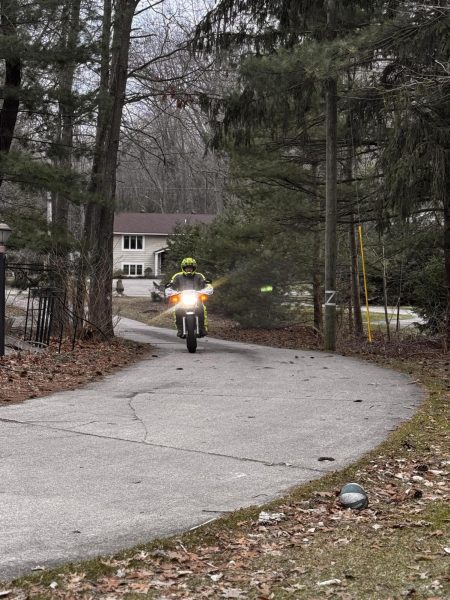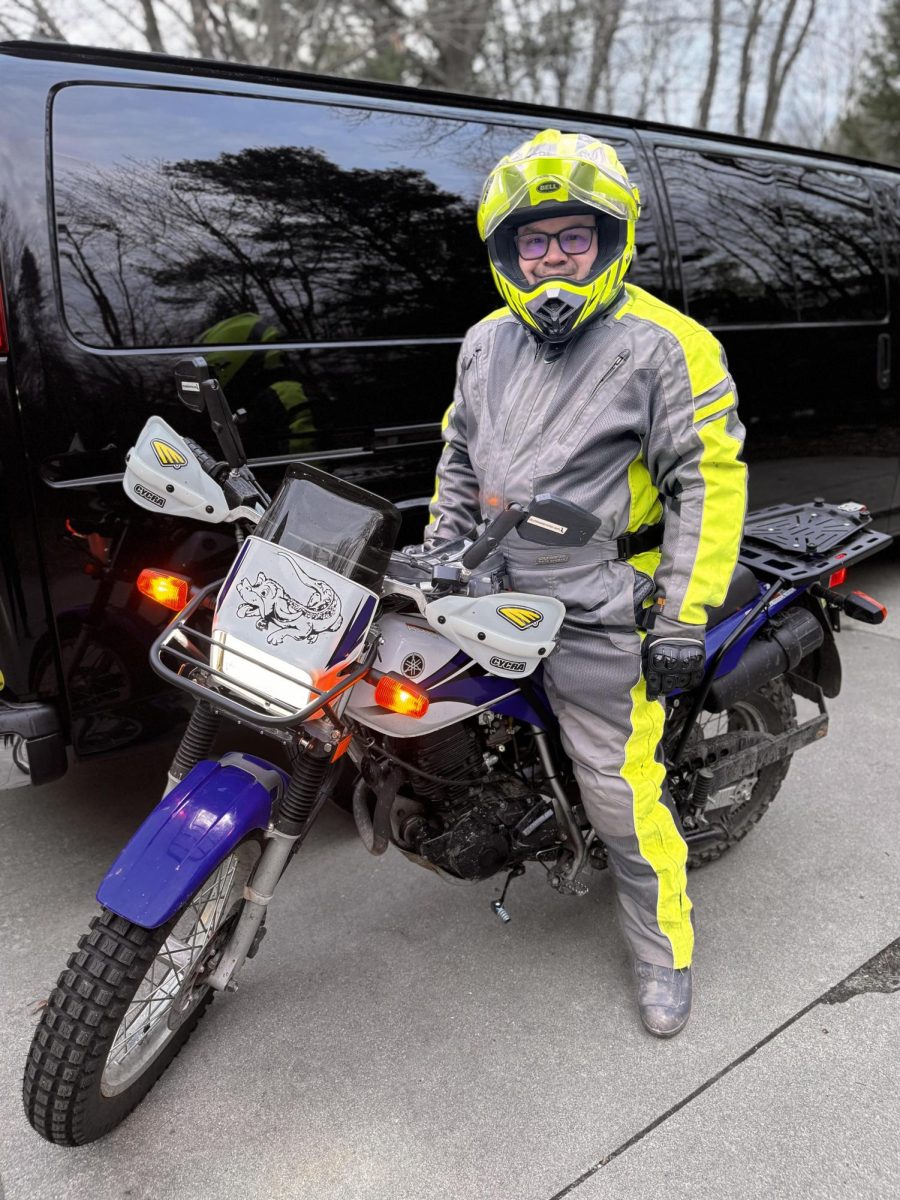The deafening wind flies past Instructor Doug Mandrick’s helmet while he zooms down the road on his motorcycle. Up ahead, a hoard of turkeys cross the road. Covered head-to-toe in gear, he grips the handlebars as he makes the split decision to speed up to pass the turkeys. As he’s passing, one flies into Mandrick, hitting his knee. His bike wobbles, but he manages to stay upright and continue on his journey safely.
Motorcycles are exciting. Cutting through the air and popping wheelies sound like a lot of fun, but staying safe is important. Mandrick stresses the importance of always wearing gear. “I would always say ATGAT, so ‘All The Gear, All the Time,’” Mandrick said. “It’s not a matter of if you’re going to crash, it’s a matter of when you’re going to crash. So at some point, every rider does it. It’s just a matter of whether you walk away or it’s a game over, or if it’s a life-changing event.”
In 2022, The National Highway Traffic Safety Administration estimated that compared to regular motor vehicles, motorcyclists were roughly 22 times more likely to die and four times more likely to be injured. Wearing the correct gear could be the difference someone needs to survive a life-or-death situation.

That’s not the only way to stay safe. Motorcycle safety courses are available through the state. “You don’t have to have a motorcycle. All you have to do is show up with long clothes on, gloves and a helmet, and closed-toed shoes,” Mandrick said. The class is $35, taking up one weekend. It includes book classwork and an enclosed course. Participants will learn the basics and how to safely navigate the world around them. “Even if you end up deciding you don’t like motorcycles after the class, you become more aware as a car or a ‘cager’ driver, as motorcyclists refer to them as, because now you have a different experience and outlook,” Mandrick said. “Oh, and it also is an insurance discount.”
For beginner riders, choosing a low CC motorcycle can also help people stay safe. “Coming from someone who’s ridden from 50 CCS all the way up to 1000 CC motorcycles, by starting out on a smaller motorcycle, you get to learn control of the bike, the acceleration, the breaking, and those are all huge components,” Mandrick said. Even a lower CC motorcycle can out accelerate sports cars, so everyone can stay safe and look cool in front of the huzz.
Motorcycles are small. Many cars may overlook them and run bikes off the road. “Assume all cars can’t see you and are likely to hit you or run you off the road as you’re small and hard to see for people that aren’t watching,” Mandrick’s friend, Mitchell Pressey, said. “You have no cage to protect you, only your awareness and acceleration.” Stay alert of the surroundings to avoid unwanted situations.
Being a passenger on a motorcycle also requires some safety precautions. “Since safety was his [Mandrick’s] top priority, he outfitted me in full body armor and a full face helmet and we installed communicators in our helmets,” Mandrick’s wife, Erica Mandrick, said. “I also took the motorcycle safety course which was tremendously helpful in learning to ride as a passenger.” It’s important to take the same precautions as a regular rider would when being a passenger.
The Motorcycle Safety Foundation (MSF) recommends passengers to wear protective gear, keep feet on the footrests at all times, and keep hands away from moving parts. Make sure to sit close to the operator to help both riders move in sync. Don’t be shy. Get cozy with the driver. Sitting close isn’t all a passenger needs to do; unless there are passenger handlebars, wrap arms around the driver or hold onto their waist or hips. Making contact with the driver helps to read the driver’s body language, keeping the passenger secure on the bike.
On the road, obstacles are bound to appear. Leaning with the driver is key to keeping upright and stable on turns. MSF said to “look over the operator’s shoulder in the direction of the corner” when turning. If the bike is crossing an obstacle or obstruction of some sort, stand on the pegs with knees slightly bent to help absorb the impact.
Making sudden movements is also dangerous as a passenger. Turning or wiggling around can cause the bike to become unsteady. The loss of balance may cause the driver to lose control of the bike, increasing the risk of the bike tipping over and causing injuries. To reduce the need to move around, make sure to take a few minutes and find a comfortable position on the bike.
Drivers will need to take precautions with a passenger too. Take caution when turning and let the passenger adjust to being on a motorcycle. “Allow time for a passenger to adjust to the sense of speed and the sensation of leaning,” MSF said. “Speeds should be conservatively safe and reasonable until a passenger acclimates to the proper riding techniques.” Have a bit of patience when passing, turning, or going over objects as the passenger gets used to riding.
If there is a quick stop or hard break, be prepared for the passenger to bump their helmet into the driver. Breaking may need greater pressure or be sooner to accommodate another person on the bike. Acceleration may need a little more throttle too. Finally, make sure the passenger dismounts first to ensure they safely get off the bike.
While flexing supermans and speeding down the highway seem fun, remember that safety is the number one priority. Make sure to take some classes, stay alert, and always wear gear.







